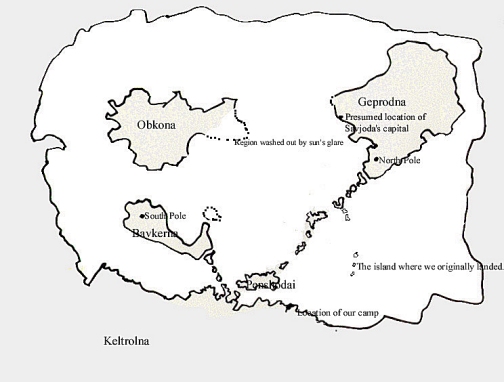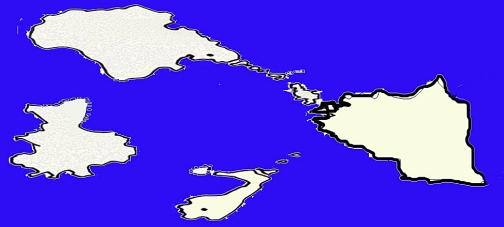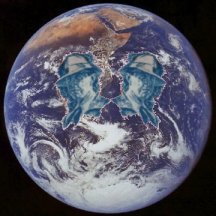In spite of the idyllic setting that my life now took
place in, I could not forget that Savjoda was out there and planning the
conquest of Barsoom.
Two more times, we witnessed the opening of roads to
the surface world. Both openings were brief, too brief to allow a major
invasion of the surface, but certainly things were happening. The most
important thing was that these openings were reminders that Savjoda's plans
moved forward while we did nothing.
In Dhaimira, as I have stated before, there are virtually
no metals, yet somehow, we had to make the tools that would allow us to
either escape this world or catch up with Savjoda. Barsoom is far older
than Earth and the ways of the primitive much farther behind the Barsoomians
than the inhabitants of Earth. It is for that reason that Tamla barely
comprehended the concept of stone tools.
On Earth, even as recently as the reign of the Kalkars,
men had chipped knives and axes out of flint, while Barsoom had lived in
the age of steel for millions of years. Tamla reacted to my inept efforts
of making tools from stone as if I had performed a magic trick.
It took me a few tries to make a useable axe-head,
but I got quite a bit of practice due to the fact that they wore out quite
quickly. The task of constructing a sturdy boat fell mostly to myself.
Having been raised on the dry sea bottoms of Barsoom, the young princess
understood little of the theory behind watercraft.
Over time, a seaworthy craft took shape. I cooked tree
sap to pitch the hull and carved pegs to hold the boards together. The
joined and pitched boards were then covered with animal hide as was a roofed
enclosure inside the craft itself. I made a sail from large leaves sewn
together. Tamla and I sailed on a few short excursions from our camp to
survey the coast and work out problems with the boat's construction.
In spite of the fact that Keltrolna was quite small
compared to any of Earth s continents, it was still of impressive size
and variety. We spent some time exploring all along the western coast where
we saw many wonders.
We had few really good choices for how we should proceed.
Tamla thought that we should head into the South Polar region where she
thought there might some sort of route into the Sea of Omean and from there
we might reach the Sea of Korus. I, on the other hand thought that the
course most likely to succeed would be to make for Savjoda s capital and
wait to see if we could get back when he next opens a road.
We devoted ourselves to the study of what might be
called Dhaimiran "astronomy." We had to create a clear map of our world
but we were subject to the sorts of limitations that were usually faced
by astronomers, that is the vicissitudes of the weather. We also had no
telescope although that was not too much of a handicap. Dhaimira's diameter
is approximately three thousand miles making it only slightly larger than
Vah-Nah. The shell of Barsoom was rather thicker by proportion than that
of Earth which encloses Pellucidar. The result of this was that the atmosphere
was considerably easier to see through than that of Pellucidar. On the
other hand, the sun effectively blanked out a larger portion of the sky
than did the sun of Pellucidar. Luckily for us, our camp was located very
near the equator and we were able to see both polar regions. We discovered
two things. The first was that we could not tell with any certainty the
direction of the planet s rotation, therefore, we remained unsure as to
which pole was which. The second of which was the presence of land masses
located over both poles making a direct sea passage to the surface unlikely.

This is a copy made from the first map we made in
western Keltrolna.
The land of Keltrolna can be seen to encircle all
the other lands and waters, for this is how it appeared from our vantage.

This is the best surmise I could make of the actual
shape of the lands of Dhaimira
if they were to be laid out flat. Geprodna is at the
top of the map and Keltrolna is on the right hand side.
We reluctantly determined that seeking out Savjoda
offered us the best chance of escape. We had, through our geographical
explorations, found a place that we believed to be Savjoda's base of operations.
It was almost on the exact opposite side of the world from us. This made
me wonder why we entered Dhaimira where we did. Were there other plans
for Tamla aside from those stated by the jomads?
I contrived a clock of sorts, really more like an ancient
sand glass. It dribbled a stream of sand from one container to another
over a period of approximately 4000 resting heartbeats. I arbitrarily decided
to call a period where we reversed the containers 20 times a day and 30
of those periods a month. Both Tamla and I felt much better with a method
of time-keeping, although now that we had one, we became aware of how fast
the time was going by.
It took us half a month to prepare supplies for our
voyage. They consisted of dried meats and wild vegetables and many skins
filled with spring water.
The darmayoks had left us a vial of their water purification
chemical, but we felt it was best to regard that as emergency stores. Also,
the water skins made good ballast and helped keep the boat from rocking
too far in one direction or the other.
We reluctantly determined that seeking out Savjoda
offered us the best chance of escape. We had, through our geographical
explorations found a place that we believed to be Savjoda s base of operations.
It was almost on the exact opposite side of the world from us. This made
me wonder why we entered Dhaimira where we did. Were there other plans
for Tamla aside from those stated by the jomads?
I contrived a clock of sorts, really more like an ancient
sand glass. It dribbled a stream of sand from one container to another
over a period of approximately 4000 resting heartbeats. I arbitrarily decided
to call a period where we reversed the containers twenty times a "day"
and thirty of those periods a "month". Both Tamla and I felt much better
with a method of time-keeping, although now that we had one, we became
aware of how fast the time was going by.
It took us half a month to prepare supplies for our
voyage. They consisted of dried meats and wild vegetables and many skins
filled with spring water.
The darmayoks had left us a vial of their water purification
chemical, but we felt it was best to regard that as emergency stores. Also,
the water skins made good ballast and helped keep the boat from rocking
too far in one direction or the other.
We set out on a calm sea using only the map we had
prepared for navigation. Frequent overcast weather made our progress slow
and before more than five days had passed, we were forced to land at the
first island we saw to wait until we could get our bearings.
The island was lushly forested with the leafy cup trees,
not unlike the one we made our escape from the jomads in, each with its
own little pond. There was ample hunting and forage for us to eat well
and replenish stocks as we needed.
Beyond the forest that lined the coast was a savanna
interrupted by occasional trees and watering holes. The ground cover was
both Earthly grasses as well as Barsoomian yellow moss, thus we were not
overly surprised to see that the land was shared by elephants and wildebeest
as well as wild thoats and zitidars. Here were also various beasts, which
were of obviously Dhaimiran origin, some of which were too fleet of foot
for us to get a clear look at. We also spotted lions and calots which convinced
us that it would be better for us to return to the coastal forest.
After some time, we determined that we were on a large
island that Tamla identified as Penshodai. This island sat at one end of
an archipelago that reached all the way to Geprodna.
If we stayed in the region of these islands for our
journey, we would always be near land and in shallow, warm waters, but
we would also be more exposed to discovery by Savjoda s jomad minions.
Even so, the limitations of our boat and our dependence on being able to
see our destination militated against attempting a long voyage on the open
ocean. Thus it was that we agreed to make our journey along the line of
islands.





![]()
![]()
![]()
